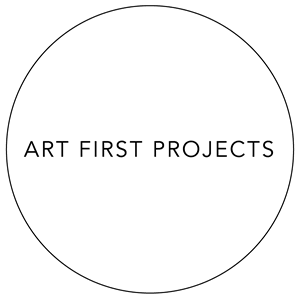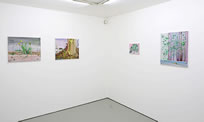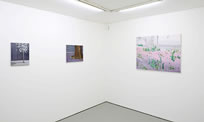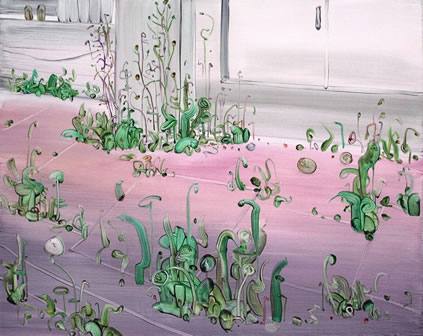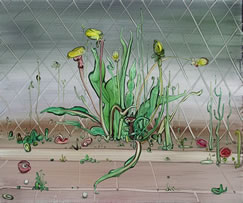Art First Projects
Mimei Thompson
Lunar Asparagus
15 October – 16 November, 2013
“Painting is not for me either decorative amusement, or the plastic invention of felt reality; it must be every time: invention, discovery, revelation”. Max Ernst (1891 – 1976)
Mimei Thompson’s new exhibition borrows the title of a 1935 sculpture by Ernst. The sculpture itself (two elongated, and awkwardly swaying forms in white plaster, currently sitting in a MOMA storage unit) is perhaps not immediately the most obvious emblem for a group of richly coloured and elegantly composed paintings. The connection lies in the the ambiguity in Ernst’s piece, the sense that it is neither one thing nor the other, or perhaps both at once. The title allows the viewer to drift between the romantic and dreamlike ‘lunar’ association, while remaining anchored to the banal and comical suffix ‘asparagus’. It is the absurdity and constant openness to interpretation of the mind’s eye that is the crux of the Surrealist movement as espoused by Ernst, Buñuel & co, and this investigation and discovery of the alien in the everyday is central also to Thompson’s work.
In her paintings Thompson delights in combinations of the grandiose and the banal, the conventional and the obscure. She leads the viewer into unfamiliar aspects and viewpoints – the compositions centre around the periphery of what might be considered typical, painterly, landscapes. Edges of pavements, bottoms of fences and patches of fallow ground provide unfamiliar compositional frameworks for the lightly and energetically rendered weeds that populate these unpretentious planes.
Thompson’s subjects are united through a quality of strangeness; the previously mentioned ‘alien in the everyday’. Her studies of animals give haunting glimpses of their inner lives, almost but not quite anthropomorphised. Her pseudo-botanical paintings of the titular asparagus are more reminiscent of specimens brought back from a distant planet than of prize-winners in a village fete.
The palette of the works and the fluid yet purposeful brushstrokes are part of a pictorial language that Thompson has developed over time to express the energy of her subjects, alongside their inherent ‘otherness’. Hues of violet, pewter and emerald, lightly flecked with dashes of cadmium yellow and magenta, wash through the ‘pavement-scapes’ of the Weeds series – while her Caves are painted in ghost-like silver and lavender tones that evoke a sense of hazy, half-forgotten memories rather than solid strata. The brushstrokes themselves become ‘forms’ in their own right, merging into the pictorial whole. This dual reading is perfectly employed in her Green Man works. Thompson writes:
The imagery of the Green Man somehow seems to link to a Gabriel García Marquez short story that I read many years ago that has continued to inform my thinking. Titled ‘The Other Side of Death’ it presents an image of the body, in death, decomposing, liquefying, and somehow remaining sentient at the same time… the idea that we are all made of one kind of matter that takes on different forms, that we return to the vegetable, on a chemical and elemental level. Also my interest in the Green Man comes from looking at Baroque / Grotesque decorations- where a figure can become a garland of leaves, an animal, etc.
This liquidity of meaning, interpretation and tone flows though Thompson’s work, leaving the viewer captivated. The swirling mass of translucent brushstrokes that slip and glide over the smooth ground of her canvases, depicting nothing more unusual than a dandelion, leave the door wide open for our imaginations to step through into that same realm of ‘invention, discovery, revelation’.
Mimei Thompson holds an MA in Fine Art (Painting) from The Royal College of Art. Prior to the RCA she studied at Central Saint Martins and the Glasgow School of Art. She was recently selected for the Jerwood Contemporary Painters and has had her work commissioned by the Contemporary Art Society and acquired by The Arts Council Collection.
